Mnemonics in trigonometry

In trigonometry, it is common to use mnemonics to help remember trigonometric identities and the relationships between the various trigonometric functions. For example, the sine, cosine, and tangent ratios in a right triangle can be remembered by representing them as strings of letters, for instance SOH-CAH-TOA in English:
- Sine = Opposite ÷ Hypotenuse
- Cosine = Adjacent ÷ Hypotenuse
- Tangent = Opposite ÷ Adjacent
One way to remember the letters is to sound them out phonetically (i.e. "SOH-CAH-TOA").[2] Another method is to expand the letters into a sentence, such as "Some Old Houses Can Always Hide Their Old Age".[3]
Communities exposed to Chinese dialect may choose to remember it as TOA-CAH-SOH, which also means 'big-footed woman' in Hokkien.
Azal's Mnemonic
Azal's Mnemonic is an alternative mnemonic to SOH-CAH-TOA for people who have different names for the legs of a triangle, i.e. Perpendicular(P) for Opposite(O) and Base(B) for Adjacent(A). Azal's Mnemonic goes like this: Some People Have Curly Black Hairs Through Proper Brushing. Here, Some People Have is for Sine=Perpendicular/Hypotenuse, Curly Black Hairs is for Cosine=Base/Hypotenuse, and Through Proper Brushing is for Tangent=Perpendicular/Base.

Mnemonic chart
Another mnemonic permits all of the basic identities to be read off quickly. Although the word part of the mnemonic used to build the chart does not hold in English, the chart itself is fairly easy to reconstruct with a little thought. (Functions without "co" appear on the left, co-functions on the right, a 1 goes in the middle, triangles point down, and the entire drawing looks like a radiation symbol.)

Reading from the 1: dividing by any edge of the hexagon equals the opposite side gives reciprocal identities:
Reading down by adding the tops of any triangle gives the standard identities (starting at the top left and going clockwise):
Reading from a function and dividing its two consecutive clockwise or counter clockwise neighbors gives these identities:
(Starting at tan and going clockwise)
(Starting at tan and going counter-clockwise)
Reading from a function, it equals the product of two nearest neighbors giving these identities (starting at tan and going clockwise):
References
- ↑ Heng, Cheng and Talbert, "Additional Mathematics", page 228
- ↑ Weisstein, Eric W. "SOHCAHTOA". MathWorld.
- ↑ A sentence that is more appropriate for high school is, "Some old horse came a'hopping through our alley." Foster, Jonathan K. (2008). Memory: A Very Short Introduction. Oxford. p. 128. ISBN 0-19-280675-0.